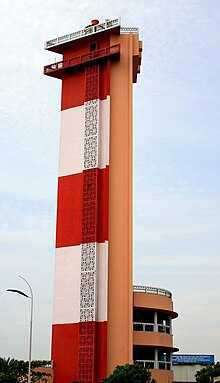Chennai Lighthouse
There have been at least four lighthouses named Chennai Lighthouse (Tamil: சென்னை கலங்கரை விளக்கம்) or Madras Lighthouse, which face the Bay of Bengal on the east coast of the Indian Subcontinent in Chennai, India.
The current lighthouse is a landmark on the Marina Beach, which was built by the East Coast Constructions and Industries in 1976, and opened in January 1977. It also houses an office of the meteorological department. On 16 November 2013, it was reopened to visitors. It is one of the few lighthouses in the world with an elevator.[1][2] It is also the only lighthouse in India within the city limits.[3] It is powered by a solar panel.[4]Location
The lighthouse is located on Kamarajar Salai (Beach Road) opposite the office of the Director General of Tamil Nadu Police and All India Radio's Chennai station. The lighthouse marks the end of the promenade on the northern half of the Marina Beach. It is also the junction where Kamarajar Salai, Santhome High Road and Dr. Radhakrishnan Salai meet. The lighthouse and the surrounding areas are served by the Light House MRTS station located nearby on Dr.Radhakrishnan Salai 13.0450°N 80.2768°E.
History
By the end of the 18th century, the Madras Presidency encompassed much of south India and also Ceylon. As its capital, the city of Madras served as the nerve centre of the sea trade controlled by the British East India Company. Ships approaching the shore of Madras after nightfall faced the risk of running aground on the shoals of Covelong (Kovalam) in the south and the sand-banks of Armagaon and Pulicat in the north.[5]
The present lighthouse is the fourth lighthouse of Chennai. Before the end of the 18th century, when Madras was an open seashore, where goods were loaded and unloaded from boats, bonfire lit by fisherwomen was used to guide the menfolk to the shore. The arrangement of exhibiting light to assist British East India Company's vessels arriving at Madras and to enter the port during the 17th and 18th centuries is not known since no record is available. The first conventional lighthouse was proposed in 1795, the very year when the first census of the city was taken. In February 1795, maritime officials petitioned the British government to build a lighthouse at Fort St. George to serve as a navigational aid, allowing vessels to enter the open anchorage at all times. The request was approved and the steeple of St. Mary's Church was considered as the site for the new lighthouse. However, the proposal did not materialise due to opposition from the chaplains. Hence, the terrace of the officer's mess-cum-exchange building (the present day's Fort Museum) was chosen as the location for the new lighthouse, and the first lighthouse started functioning in 1796. It used a large oil-wick lantern to aid vessels approaching the port. Situated at 99 feet above sea level, it had 12 lamps fuelled by coconut oil.[5] Small country mirrors were used as reflectors.[6] The beam emanating from the lamp swept the sea as far as 25 miles from the shore. Signals were exchanged with the lighthouse by merchants on the ship, who would conduct all the transactions later in the Public Exchange Hall downstairs, which served as a meeting point for brokers, merchants, and commanders of ships. The first lighthouse functioned till 1841.[5]
